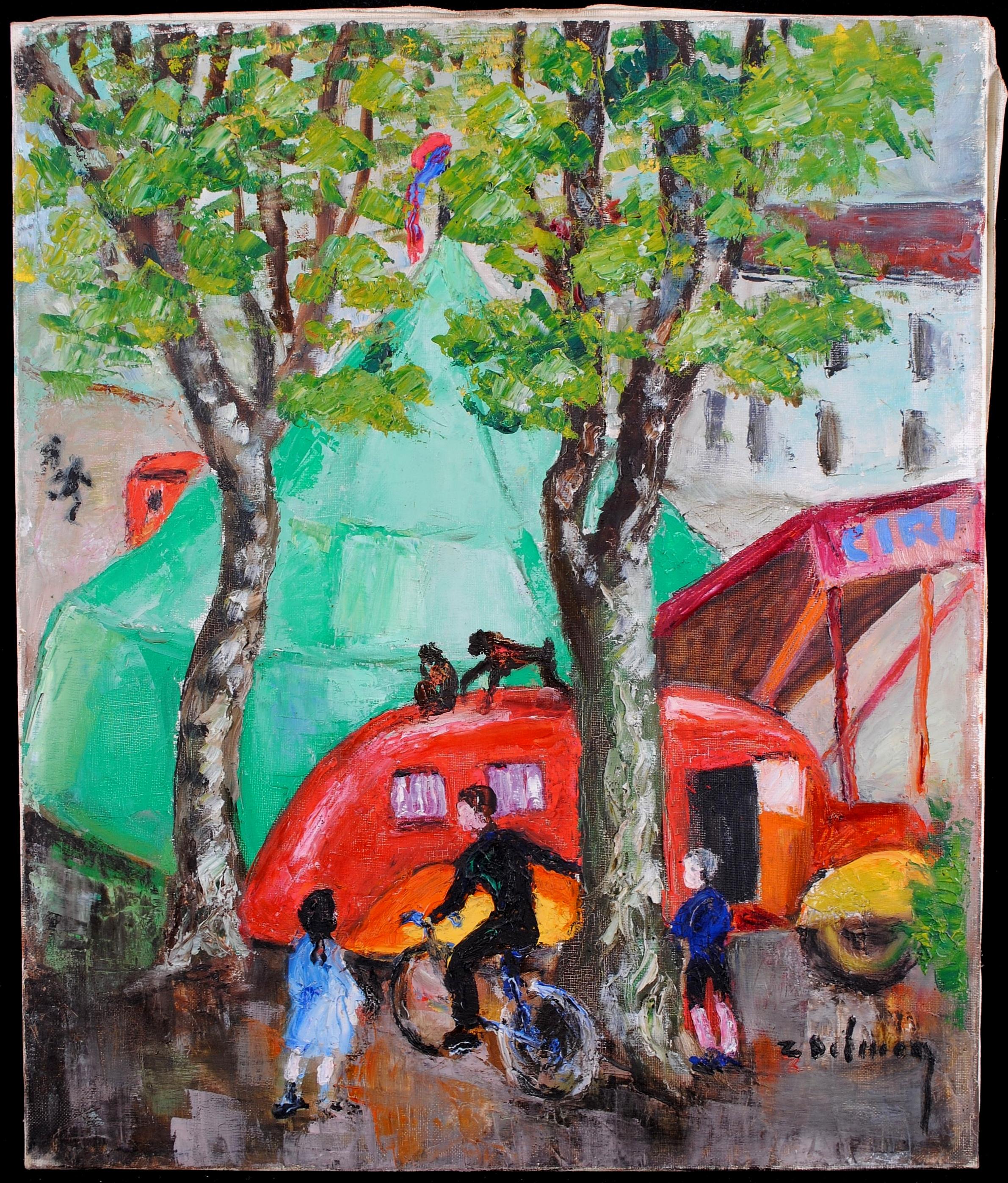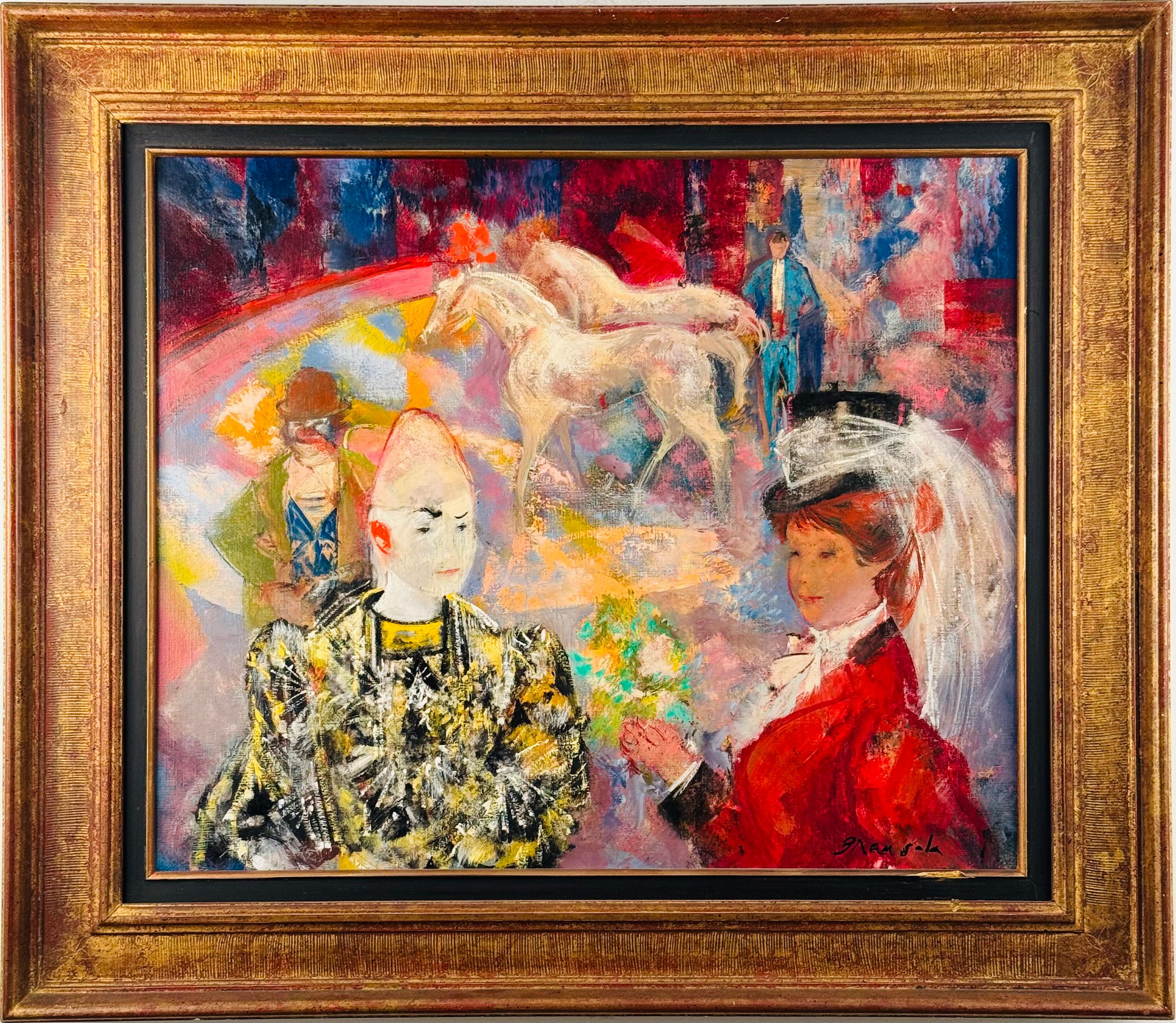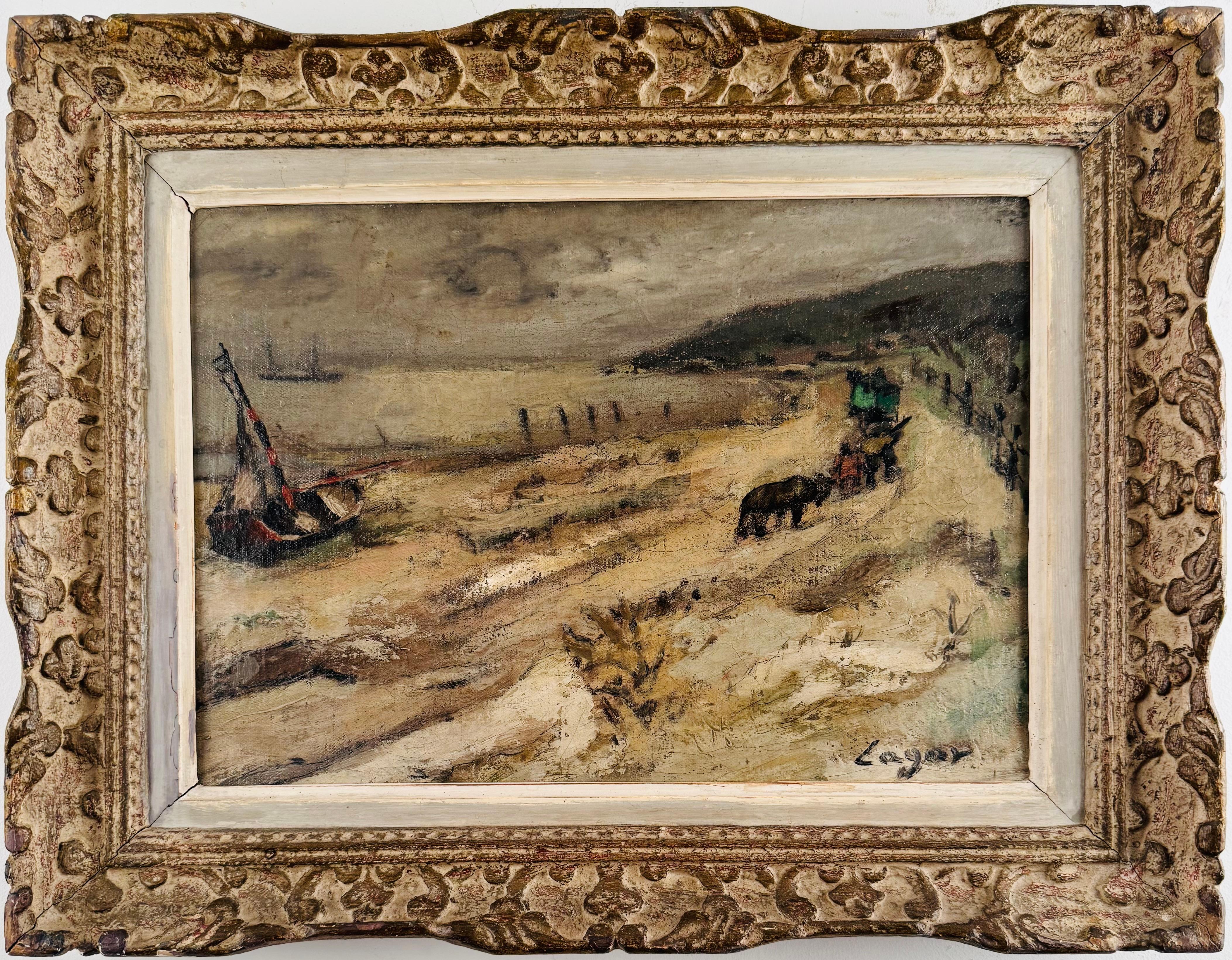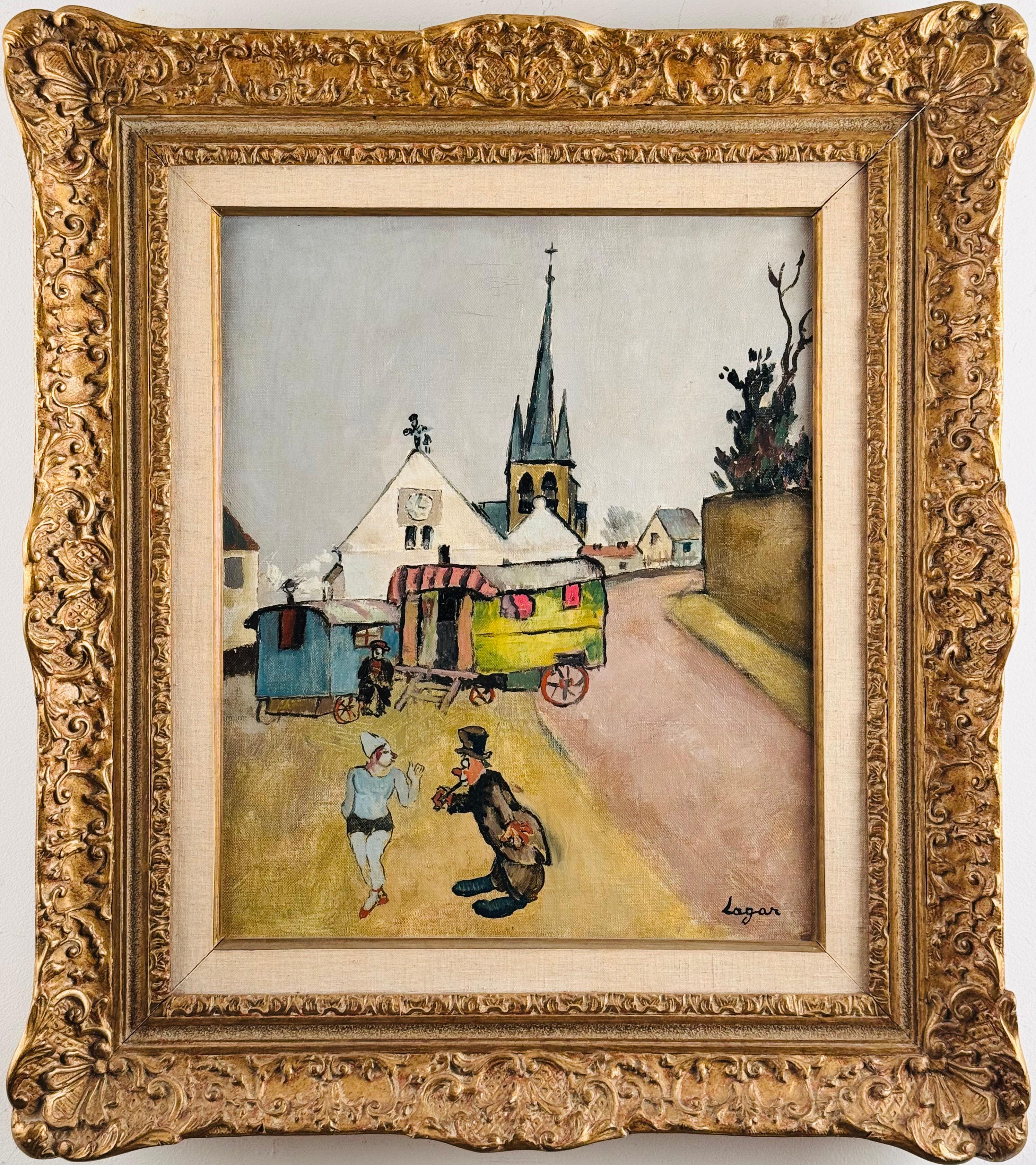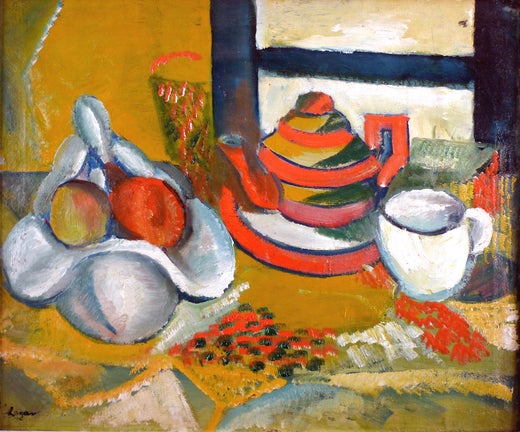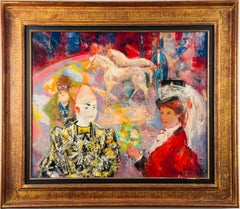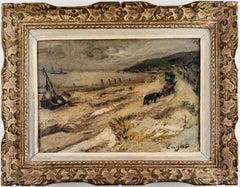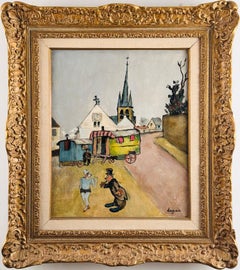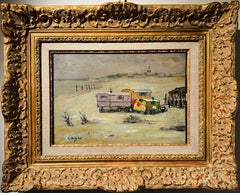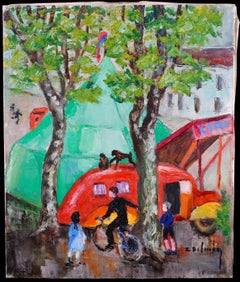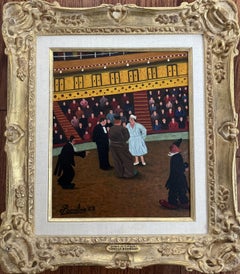Items Similar to Pavillon de Cirque
Want more images or videos?
Request additional images or videos from the seller
1 of 12
Celso LagarPavillon de CirqueCirca 1938
Circa 1938
$17,886.93
£13,379.28
€15,000
CA$24,712.27
A$26,946.08
CHF 14,300.01
MX$325,769.34
NOK 180,977.04
SEK 165,890.63
DKK 114,275.24
About the Item
CELSO LAGAR
Spanish, 1891 - 1966
PAVILLON DE CIRQUE
signed "Lagar" (lower right)
oil on canvas
15 x 18 inches (38 x 46 cm.)
framed: 21-1/2 x 24-1/2 inches (54 x 62 cm.)
NOTE:
THIS WORK IS ACCOMPANIED BY A CERTIFICATE OF AUTHENTICITY ISSUED BY “ARCHIVO CELSO LAGAR”.
PROVENANCE
Crane Kalman Gallery, London
Sir Leon and Lady Bagrit (acquired in July 1962)
Private Collection, UK
Private Collection, Madrid
Celso Lagar Arroyo (Ciudad Rodrigo, 1891 - Seville, 1966) was an expressionist Spanish painter of the first generation of the School of Paris, where he lived most of his life. He was influenced by avant-gardes of all kinds, such as cubism and fovism. He painted mainly landscapes and still lifes. From a personal point of view, he is a depressive person and completely dependent on his wife, the French sculptor Hortense Begué.
From his native Ciudad Rodrigo, he went to Madrid to be part of the workshop of one of the best sculptors of the moment, Miguel Blay. During 1910 and 1911 he visited Barcelona. Later he studied sculpture in Paris in 1911 advised by Blay, where he met Joseph Bernard, his friend Amedeo Modigliani and his future wife, the French sculptor, Hortense Begué. It will be precisely at that moment when, gradually, he leaves the sculpture in favor of painting.
The outbreak of the First World War will mean, in the life and work of Celso Lagar, the beginning of a new stage. He remained in Barcelona during the war, where he achieved a certain recognition, which allows him to return to Paris. In 1919 he settled permanently in France. His time until the end of the 30s, is the moment of his greatest splendor of the artist. He manages to exhibit his works in the best Parisian galleries, his production is abundant and constant. Both in his residence in Paris and in his rooms, since 1928, in Normandy he will develop an artistic production with very specific themes: still lifes, Spanish reminiscences, landscapes and his celebrated circus scenes. After the period of avant-garde influences of all kinds (Cubism, Fauvism, Vibrationism, Biologism, Simultaneism, Ultraist, ...), Celso Lagar will find his own path marked mainly by Goyesque and Picasian inspiration. Critical and public recognition increases.
With the onset of World War II, its golden age will end. Lagar and Hortense are forced to take refuge in the French Pyrenees amid very difficult living conditions. His return after the liberation of Paris did not have such an impact. Lagar will continue with the same themes and techniques before the war but the public is already looking for new content. Gradually, success fades and economic hardships affect the couple.
At this time around the year 1950, his wife Hortense enters the hospital Broca and in 1955 dies. Lagar falls into a deep depression and will enter the psychiatric hospital of Sainte Anne. His artistic work ends completely. At that time, by court order, two auctions of the works that remained in his workshop are held, to pay for his stay in the asylum. In October 1964 he returned to Spain living in Seville with a sister until his death on September 6, 1966.
His paintings are found in numerous museums throughout Europe, such as: La Rochelle, Goya Museum in Castres, Honfleur (France), Petit-Palais de Geneva, Reina Sofía National Art Center Museum, Casa Lis de Salamanca, Carmen Thyssen Museum ( Malaga) and in prestigious collections such as Crane Kallman (London) or Zborowski (Paris).
He was illustrator of several magazines, among them, the Spanish Magazine Nova, Un enemic del Poble and Troços.
- Creator:Celso Lagar (1891 - 1966, Spanish)
- Creation Year:Circa 1938
- Dimensions:Height: 14.97 in (38 cm)Width: 18.12 in (46 cm)
- More Editions & Sizes:38 x 46 cm.Price: $17,887
- Medium:
- Movement & Style:
- Period:
- Condition:
- Gallery Location:Madrid, ES
- Reference Number:1stDibs: LU1281115830812
Celso Lagar
Celso Lagar Arroyo (Ciudad Rodrigo, 1891 - Seville, 1966) was an expressionist Spanish painter of the first generation of the School of Paris, where he lived most of his life. He was influenced by avant-gardes of all kinds, such as cubism and fovism. He painted mainly landscapes and still lives. From his native Ciudad Rodrigo, he went to Madrid to be part of the workshop of one of the best sculptors of the moment, Miguel Blay. During 1910 and 1911 he visited Barcelona. Later he studied sculpture in Paris in 1911 advised by Blay, where he met Joseph Bernard, his friend Amedeo Modigliani and his future wife, the French sculptor, Hortense Begué. It will be precisely at that moment when, gradually, he leaves the sculpture in favor of painting. The outbreak of the First World War will mean, in the life and work of Celso Lagar, the beginning of a new stage. He remained in Barcelona during the war, where he achieved a certain recognition, which allows him to return to Paris. In 1919 he settled permanently in France. His time until the end of the 30s, is the moment of his greatest splendor of the artist. He manages to exhibit his works in the best Parisian galleries, his production is abundant and constant. Both in his residence in Paris and in his rooms, since 1928, in Normandy he will develop an artistic production with very specific themes: still lifes, Spanish reminiscences, landscapes and his celebrated circus scenes. After the period of avant-garde influences of all kinds (Cubism, Fauvism, Vibrationism, Biologism, Simultaneism, Ultraist, ...), Celso Lagar will find his own path marked mainly by Goyesque and Picasian inspiration. Critical and public recognition increases. With the onset of World War II, its golden age will end. Lagar and Hortense are forced to take refuge in the French Pyrenees amid very difficult living conditions. His return after the liberation of Paris did not have such an impact. Lagar will continue with the same themes and techniques before the war but the public is already looking for new content. Gradually, success fades and economic hardships affect the couple. At this time around the year 1950, his wife Hortense enters the hospital Broca and in 1955 dies. Lagar falls into a deep depression and will enter the psychiatric hospital of Sainte Anne. His artistic work ends completely. At that time, by court order, two auctions of the works that remained in his workshop are held, to pay for his stay in the asylum. In October 1964 he returned to Spain living in Seville with a sister until his death on September 6, 1966. His paintings are found in numerous museums throughout Europe, such as: La Rochelle, Goya Museum in Castres, Honfleur (France), Petit-Palais de Geneva, Reina Sofía National Art Center Museum, Casa Lis de Salamanca, Carmen Thyssen Museum ( Malaga) and in prestigious collections such as Crane Kallman (London) or Zborowski (Paris).
About the Seller
5.0
Vetted Professional Seller
Every seller passes strict standards for authenticity and reliability
Established in 1977
1stDibs seller since 2019
21 sales on 1stDibs
Typical response time: 2 hours
- ShippingRetrieving quote...Shipping from: Madrid, Spain
- Return Policy
More From This Seller
View AllGens du cirque
By Emilio Grau Sala
Located in Madrid, ES
EMILIO GRAU SALA
Spanish, 1911 - 1975
GENS DU CIRQUE
signed "Grau Sala" (lower right)
signed, titled, located and dated "Grau Sala / Gens du cirque / París 72" (on the reverse)
oil o...
Category
1970s Post-Impressionist Figurative Paintings
Materials
Canvas, Oil
Forains sur la plage
By Celso Lagar
Located in Madrid, ES
CELSO LAGAR
Spanish, 1891 - 1966
FORAINS SUR LA PLAGE
signed "Lagar" (lower right)
signed, located, dated and titled “Lagar Pennedepie sur Honfleur / 1951 / Forains dans la Grove” (o...
Category
1950s Fauvist Landscape Paintings
Materials
Canvas, Oil
Fairgoers in front of roulottes
By Celso Lagar
Located in Madrid, ES
CELSO LAGAR
Spanish, 1891 - 1966
FAIRGOERS IN FRONT OF ROULOTTES
signed "Lagar" (lower right)
oil on canvas
18-1/4 x 15 inches (46 x 38 cm.)
framed: 29-1/4 x 26 inches (74 x 66 cm.)
PROVENANCE
Private French Collector
Celso Lagar Arroyo (Ciudad Rodrigo, 1891 - Seville, 1966) was an expressionist Spanish painter of the first generation of the School of Paris, where he lived most of his life. He was influenced by avant-gardes of all kinds, such as cubism and fovism. He painted mainly landscapes and still lifes...
Category
1930s Fauvist Landscape Paintings
Materials
Canvas, Oil
"Les Roulottes", 20th Century Oil on Wood Panel by Spanish Artist Celso Lagar
By Celso Lagar
Located in Madrid, ES
CELSO LAGAR
Spanish, 1891 - 1966
LES ROULOTTES
signed "Lagar" (lower left)
oil on wood panel
9-1/2 x 13 inches (24 x 33 cm.)
framed: 17-1/8 x 21-1/2 inches (43.5 x 54.5 cm.)
PROVEN...
Category
1930s Fauvist Figurative Paintings
Materials
Oil, Wood Panel
"Le Moulin de la Galette", Large 20th Century oil on canvas by Emilio Grau Sala
By Emilio Grau Sala
Located in Madrid, ES
EMIILIO GRAU SALA
Spanish, 1911 - 1975
LE MOULIN DE LA GALETTE
signed Grau Sala (lower right)
oil on canvas
59-1/4 X 67-1/4 inches (150.5 X 170 cm.)
framed: 62-1/2 X 70-1/4 inches (...
Category
1930s Post-Impressionist Figurative Paintings
Materials
Canvas, Oil
Francisco Bores, Sans titre
By Francisco Bores
Located in Madrid, ES
FRANCISCO BORES
Spanish, 1898 - 1972
SANS TITRE
signed and dated "Borès 42" (lower left)
oil on panel
13-3/4 x 10-5/8 inches (35 x 27 cm.)
framed: 19 x 15-3/4 inches (48 x 40 cm.)
BIBLIOGRAPHY:
Francisco Bores, Reasoned Catalogue, Volume I - Painting 1917-1944, Museo Nacional Centro de Arte Reina Sofía, Madrid, 2003, nº 1942 / 63, reproduced in p. 494
PROVENANCE
Carmen Bores Collection, Francisco Bores daughter
Private Collection, Madrid
Francisco Bores López (Madrid, May 5, 1898 - Paris, May 10, 1972) was a Spanish painter of the so-called New School of Paris.
His artistic training originated both in the Cecilio Pla painting academy, where he met Pancho Cossío, Manuel Ángeles Ortiz or Joaquín Peinado, and in the literary gatherings in Madrid related to ultraism.
At this time he made engravings and woodcuts for a large number of magazines such as Horizonte, Cruz y Raya, Index, Revista de Occidente. In 1922 he participated in the National Exhibition of Fine Arts.
In 1925 he participated in the first exhibition of the Iberian Artists Society. The limited success of this exhibition pushes him to go to Paris. In this city he shared a studio with the Spanish painter Pancho Cossío and also met Picasso and Juan Gris.
In 1927 he held his first solo exhibition in Paris. From this moment on, Bores integrates himself into the Parisian artistic environment where he will live practically his entire life. In 1928, his first exhibition in a gallery in the United States, in 1930 he exhibited again, within a group exhibition at the Museum of Modern Art in New York.
In the following years, he continued exhibiting in different galleries in Paris, such as the Georges Petit Gallery, the Bernheim Gallery and the Vavin Raspail Gallery. He also participates in several group exhibitions, highlighting the Exhibition of Contemporary Spanish Art...
Category
1940s Fauvist Interior Paintings
Materials
Oil, Panel
You May Also Like
At the Circus I, Impressionist Oil Painting by Charles Cobelle
By Charles Cobelle
Located in Long Island City, NY
Artist: Charles Cobelle, French (1902 - 1994)
Title: At the Circus I
Medium: Oil on Canvas, signed l.r.
Size: 24 x 20 in. (60.96 x 50.8 cm)
Frame Size: 30 x 26 inches
Category
Mid-20th Century Fauvist Figurative Paintings
Materials
Canvas, Oil
Circus - Mid 20th Century French Modernist Oil on Canvas Figurative Painting
Located in Sevenoaks, GB
* No US duty or taxes to pay on this item *
An unusual mid 20th century French oil on canvas depicting figures outside a circus with big top tent, monkeys on a caravan and parrot in...
Category
1950s Modern Landscape Paintings
Materials
Canvas, Oil
Le Cirque (The Circus) I
By Camille Hilaire
Located in San Francisco, CA
This artwork titled "Le Cirque (The Circus)" is an original colors lithograph by noted French artist Camille Hilaire, 1916-2004. It is hand signed and inscribed J/2 in pencil by the ...
Category
Late 19th Century Impressionist Figurative Prints
Materials
Lithograph
Le Cirque
By Camille Bombois
Located in New York, NY
Le Cirque is a rare and most sought after image by the artist of the circus by collectors of Bombois.
This painting shows the circus ring where the performers would perform, the audience of spectators, the ring master & the clown holding a bomb behind his back. It is a painting of GREAT detail.
Bombois was a self taught artist and a strongman with the circus.
Painting is in a 23 K. hand carved frame, linen mat & 23 K. gold leaf bevel & hand painted 23K. name plate.
The painting & frame are in pristine condition.
Photo certificate of Perls Gallery...
Category
1940s Expressionist Figurative Paintings
Materials
Oil
The Fairground - 1950's French Expressionist Mid Century Oil Canvas Painting
Located in Sevenoaks, GB
A wonderful 1950's French expressionist oil on canvas depicting figures at a fairground, by Parisian artist André Beaucé.
Excellent quality work painted...
Category
1950s Expressionist Landscape Paintings
Materials
Canvas, Oil
Funfair - 1950's French Expressionist Mid Century Oil on Canvas Painting
Located in Sevenoaks, GB
A wonderful 1950's French expressionist oil on canvas depicting figures at a busy funfair, by Parisian artist André Beaucé.
Excellent quality work painted with thick impasto brush work. Signed lower centre.
Artist: André Beaucé (French, 1911-1974)
Title: Funfair
Medium: Oil on canvas
Size: 25.5 x 21 inches (65 x 54 cm)
André Beaucé was a French painter born on May 23, 1911 in Rennes and died on January 2, 1974 in Paris .
A pupil of the School of Fine Arts in Rennes, a graduate of the National School of Decorative Arts where he was admitted in 1932, André Beaucé was a pupil in the workshops of André Lhote and Simon, with Yves Brayer .
He won the Abd-el-Tif prize in 1946 and was a regular at the Salon d'Automne.
After having lived for several years in Algeria, and in particular at Villa Abd El Tif where he was a scholarship holder from 1946 to 1948, André Beaucé returned to France in 1949 and resumed his teaching at the Schools of Paris.
His painting is then powerfully expressionist, free from any system. In the 1950s, we notice vigorous, uncompromising, intense portraits, captured in an almost caricatural way.
The tones, always very mounted, are opposed with force in a composition cut with vigor.
After the dark years of the war, Beaucé’s art reflects a violent vision of a certain reality that is always brutal and yet magnificent.
Exhibitions
Paris, 1936 to 1945, Salon of the National Society of Fine Arts .
Tunis, 1946, Exhibition of French Africa.
Algiers, 1947, Abd-el-Tif.
Paris, 1948, Letourneur gallery.
Paris, from 1950 to 1960, Salon d'Automne and Salon Comparaisons .
Paris, 1962, Roy's gallery.
Paris, May 1963, Exhibition organized on the occasion of the Estates General on Disarmament , Cercle Volney.
First Salon Biarritz - San Sebastian: School of Paris - Painting, sculpture: André Beauce, Georges-André Klein , Adrienne Jouclard , Jean Joyet , Robert Lotiron , Roland Bierge , Andrée Bordeaux-Le Pecq , Henri Hayden , Franck Innocent , Germaine Lacaze...
Category
1950s Expressionist Landscape Paintings
Materials
Canvas, Oil
$1,963 Sale Price
20% Off
Free Shipping
More Ways To Browse
Indian Man Painting
Jasmine Painting
Kader Boly
Lawyer Painting
Mario Tozzi
Michael Magrin
Native American Artist Paintings
Oil Painting Priest
Oil Paintings Paris Cafe
Paintings By Esther
Rebecca Johnson
Rene Smoorenburg
Rob Alexander
Salome With The Head Of John The Baptist
Samantha Buller
Street Art Painting Basquiat
Susanna And The Elders
Tamar Sulakvelidze
